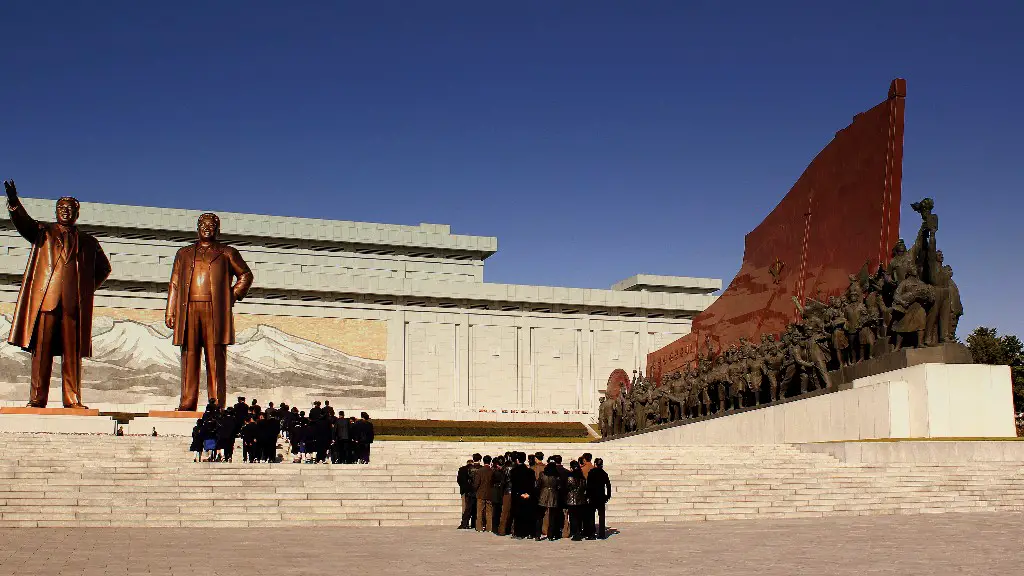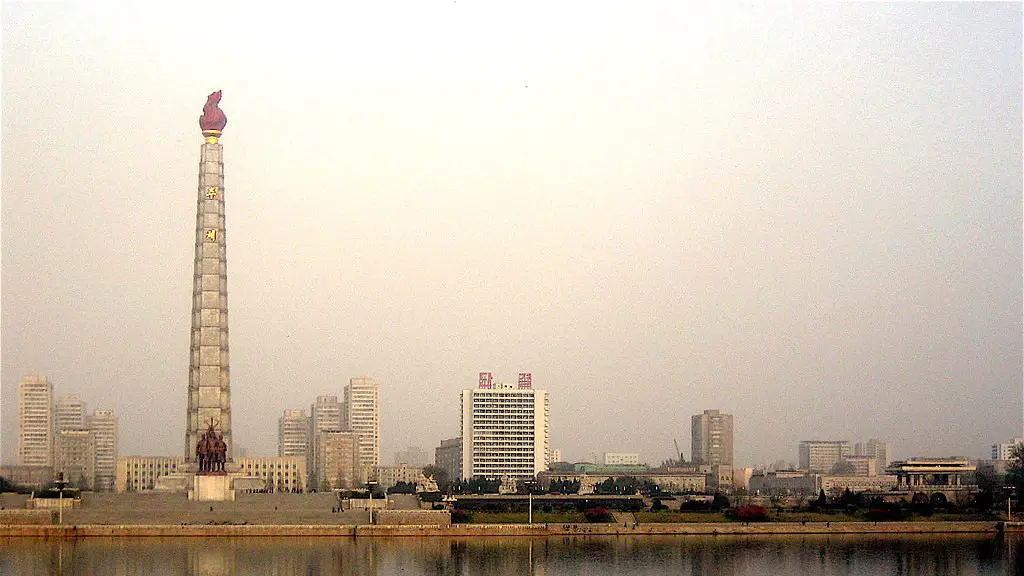Explaining Why North Korea and South Korea Are Separated
The long-running feud between North and South Korea is one of the most divisive and emotive conflicts in the world. With powerful neighbors like China and Japan, as well as the United States, involved, it’s no surprise that the two Koreas are very cautious around each other. To answer why North Korea and South Korea are so divided, we must look back to the end of World War II and learn about the politics that separated the two countries.
At the close of World War II, the Soviet and American military had occupied what was then known as the Korean Peninsula and began making arrangements for the peninsula to become two separate countries. In 1948, South Korea declared its independence and established a democratic government, while North Korea maintained its ties to the communist government in the Soviet Union. Since then, North and South Korea have become increasingly separate politically and economically, culminating with the Korean War of 1950.
The Korean War lasted three years and devastated both North and South Korea, resulting in the death and displacement of hundreds of thousands of people. In addition, the war left a deep animosity between the two sides, with North Korea feeling as though it was betrayed by its southern neighbor. The war also further divided North and South Korea, as North Korea increasingly turned to the Soviet Union, while South Korea shifted its allegiance to the United States.
North Korea and South Korea have remained divided for more than sixty years, and the animosity between the two sides has only grown stronger over the years. North Korea has become increasingly isolated from the international community and has continued to maintain a totalitarian system of government, while South Korea has continued to build its economic and political ties with the United States and other western powers. In addition, North Korea has built up a formidable military, while South Korea has maintained a large but largely symbolic military.
Currently, the main source of contention between North and South Korea remains the border between the two countries. North and South Korea continue to dispute the location of the border, resulting in occasional military skirmishes. In addition, the North Korean government continues to make provocative statements regarding South Korea and the United States, leading to further tension between the two sides. Finally, the North Korean government has made it clear that it has no intention of reunifying with South Korea.
With no end in sight, the division between North and South Korea is likely to remain for the foreseeable future. As long as North Korea continues its nuclear weapons program, the risk of conflict between the two Koreas remains high, and it is likely that the two countries will remain divided. However, there is still hope that one day the two sides will be able to reconcile their differences and reunite.
Background and History of the Separation
The division of Korea is the result of the culmination of two centuries of contact between countries in East Asia and Russia, China, and Japan in the 19th century. The modern division of Korea began with the Japanese occupation of Korea in 1910. The Japanese sought to control Korea as part of its imperial ambitions and as a way to gain control over the region’s considerable natural resources. As a result, many Koreans were forced into rural work in Japan. After World War II, when Japan surrendered to the Allied forces, the Soviet Union and the United States quickly established a military presence in Korea.
In 1945, the Soviet Union and the United States divided Korea into two occupation zones. The United States established the Republic of Korea government in the south, while the Soviet Union established the Democratic People’s Republic of Korea in the north. This occupation would lead to a complete division of Korea in 1948 when the Korean War broke out. By 1953, the war had ended with an armistice agreement, but the border between North and South Korea was never officially drawn.
Since 1953, North and South Korea have followed two very different paths. While South Korea has become a prosperous nation with a vibrant democratic government and thriving economy, North Korea has remained a brutally oppressive and isolated dictatorship. As a result, the two Koreas have become increasingly divided with little hope of reconciliation. Despite ongoing efforts to promote peace and reunification, it is likely that the two Koreas will remain divided for the foreseeable future.
International Relationships and Regional Consequences of the Separation
The division of Korea has had significant consequences for the international community. In the United States, the Korean War resulted in the deployment of large numbers of troops and a significant buildup of military hardware. In addition, for years the United States maintained a large troop presence in South Korea as part of the United Nations’ efforts to maintain peace on the peninsula. The United States also played a large role in its support for the South Korean government.
The Soviet Union also played an integral role in maintaining the division of Korea. The Soviet Union maintained close ties with North Korea and supported its development of nuclear weapons and the continuation of its oppressive regime. The Soviet Union also helped North Korea develop its military strength, while also attempting to stoke tensions on the Korean peninsula. As a result of the tension between the two Koreas, the Soviet Union was able to maintain a significant presence in East Asia.
The division of Korea has also had significant consequences for China and Japan. China, which shares a border with North Korea and has maintained close ties with North Korea since the Korean War, fears a potential collapse of the regime in Pyongyang. Similarly, Japan fears that a reunified Korea could prove to be a potential rival if it ever unified under a single government, and has for years maintained a policy of distancing itself from both Koreas.
Prospects of Reconciliation
The prospects for reconciliation between North and South Korea remain bleak, as the two sides remain deeply divided and hostile towards each other. North Korea has made it clear that it has no intention of reunifying with South Korea, and the two sides have yet to reach any lasting peace agreement. In addition, North Korea’s nuclear weapons program continues to pose a significant threat to peace and stability on the Korean peninsula.
In recent years, however, there have been some positive signs that the two sides may be able to reconcile. In 2018, North Korean leader Kim Jong-un and South Korean President Moon Jae-in met in the first inter-Korean summit in over a decade. At the summit, the two leaders agreed to work towards peace and reunification, and subsequent talks have focused on economic and cultural exchanges between the two sides.
While it is unclear if the two Koreas will eventually be able to reconcile, the meeting between President Moon and Kim Jong-un is a promising sign. However, with the North Korean nuclear weapons program still posing a significant threat and the two sides still unable to reach any kind of lasting peace agreement, the prospects for reunification remain dim.
Cultural Division as a Result of Separation
The division of Korea has also had a significant cultural impact on both North and South Korea. While the Korean culture and language are very similar, the two countries have developed distinct cultural identities over the past several decades. North Korea in particular has developed its own distinct culture, with its own unique language, music, and customs.
The two Koreas have also experienced a significant divide in popular culture. South Korea is widely recognized for its vibrant music and entertainment industry, which has become extremely popular in an international context. In contrast, North Korea has developed a much more isolated culture, with its citizens only exposed to state-sanctioned music, films, and television shows. As a result, the cultural gap between North and South Korea has only grown.
The two Koreas also have different approaches to religion. South Korea is largely a secular society, with some traditional religious beliefs such as Buddhism and Confucianism still present. North Korea, on the other hand, has adopted an official state ideology of Juche, or self-reliance, and is highly suspicious of any foreign religious practices. As a result, religion is a highly divisive issue between the two Koreas.
The Prospects of Reunification
The prospects of reunification between North and South Korea depend heavily on the North Korean government’s willingness to make concessions and abandon its nuclear weapons program. While North Korea has expressed an interest in unity in the past, it has also made it clear that it will not do so until its security and sovereignty are guaranteed. As a result, it is unlikely that the two Koreas will be able to reunify in the near term.
The challenge for the international community is to come up with a solution to the conflict that provides North Korea with a degree of security, while also allowing for the reunification of the Korean peninsula. This will require a significant commitment from the United States, China, and other key stakeholders, as well as a willingness by North Korea to make significant concessions. Until this commitment is made, the prospects of reunification remain bleak.
Conclusion of Relationships between North Korea and the International Community
North Korea’s relationship with the international community has largely been defined by its intransigence and its refusal to negotiate. Over the years, North Korea has resisted international engagement and maintained a policy of self-imposed isolation. This has resulted in the country being largely cut off from the global economy and having limited access to foreign resources.
In recent years, however, North Korea has made some attempts to re-engage with the international community. In 2018, North Korean leader Kim Jong-un met with the US President Donald Trump and other world leaders in a historic summit that resulted in a renewed commitment to dialogue between the two sides. While the result of this summit remains to be seen, it is clear that North Korea is willing to engage with the international community.
For now, however, North Korea’s relationship with the international community remains strained. North Korea is still heavily reliant on its powerful ally China, as well as its nuclear weapons program, to ensure its security. As a result, the prospects of North Korea reunifying with South Korea remains unlikely in the near term.





